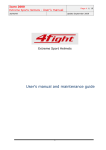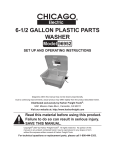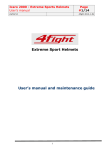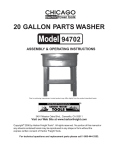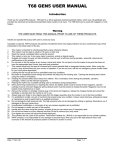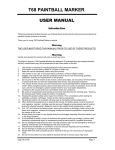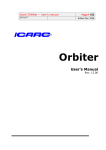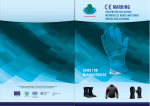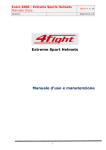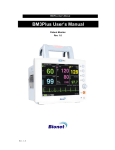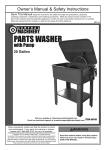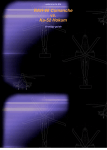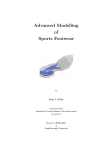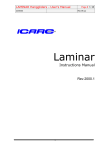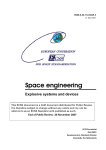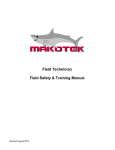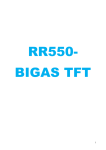Download complete test report here
Transcript
EC TYPE EXAMINATION CERTIFICATE Société Nationale de Certification et d’Homologation Société à responsabilité limitée The Société Nationale de Certification et d’Homologation s.à r.l. (SNCH) Luxembourg certifies in accordance with SNCH procedures that the Manufacturer named in column 1 fulfils the provisions of the Directive 89/686/EC Annex II for personal protective equipment 1. Manufacturer: 2. EC Conformity Certificate No: 3. Certificate Holder: 4. Notified body, delivering the certificate: 5. EC Directive Applicable: 6. Number of test report: 7. Description of Equipment: - Type of equipment: - Trade mark: - Type: - Commercial Brand: - Type of airborne helmet: - Size(s): Helmet for airborne sports ICARO2000 OMEGA 2 4 fight HELMET UL XXL/64-63, XL/62-61, L/60-59, M/58-57, S/56-55, XS/54 8. Statement of Conformity: It has been verified that the manufacturer meets the provisions of the Directive. 9. Certificate valid: Place: Date: Stamp and Signature: 15.01.2018 Sandweiler th January 16 , 2013 Remarks: Adresse: BP 23 L-5201 Sandweiler ICARO 2000 S.r.l Via Verdi. 19 I-21038 Sangiano (VA) SNCH*89/686*96/58*0128*00 ICARO 2000 S.r.l Via Verdi. 19 I-21038 Sangiano (VA) Société Nationale de Certification et d'Homologation No. 0499 89/686/EC amended by 96/58/EC, Annex II, EN 966: 2006 EN 166: 2001; EN 167: 2001; EN 168: 2001 28105510 001 Siège social: 11, route de Luxembourg L-5230 Sandweiler Claude LIESCH Directeur not applicable Capital social: 3.500.000 € R.C. B 27180 N° TVA: LU 13770825 Tél.: (+352) 35 72 14 - 250 Fax: (+352) 35 72 14 - 244 E-mail: [email protected] Home page: www.snch.lu SNCH*89/686*96/58*0128*00 Société Nationale de Certification et d'Homologation L-5201 SANDWEILER (Luxembourg) Organisme accrédité OLAS EN 45011 Accréditation N° 5/001 (Portée communiquée sur demande) SNCH*89/686*96/58*0128*00 Société Nationale de Certification et d'Homologation L-5201 SANDWEILER (Luxembourg) Organisme accrédité OLAS EN 45011 Accréditation N° 5/001 (Portée communiquée sur demande) SNCH*89/686*96/58*0128*00 Société Nationale de Certification et d'Homologation L-5201 SANDWEILER (Luxembourg) Organisme accrédité OLAS EN 45011 Accréditation N° 5/001 (Portée communiquée sur demande) SNCH*89/686*96/58*0128*00 Société Nationale de Certification et d'Homologation L-5201 SANDWEILER (Luxembourg) Organisme accrédité OLAS EN 45011 Accréditation N° 5/001 (Portée communiquée sur demande) SNCH*89/686*96/58*0128*00 Société Nationale de Certification et d'Homologation L-5201 SANDWEILER (Luxembourg) Organisme accrédité OLAS EN 45011 Accréditation N° 5/001 (Portée communiquée sur demande) SNCH*89/686*96/58*0128*00 Société Nationale de Certification et d'Homologation L-5201 SANDWEILER (Luxembourg) Organisme accrédité OLAS EN 45011 Accréditation N° 5/001 (Portée communiquée sur demande) SNCH*89/686*96/58*0128*00 Société Nationale de Certification et d'Homologation L-5201 SANDWEILER (Luxembourg) Organisme accrédité OLAS EN 45011 Accréditation N° 5/001 (Portée communiquée sur demande) SNCH*89/686*96/58*0128*00 Société Nationale de Certification et d'Homologation L-5201 SANDWEILER (Luxembourg) Organisme accrédité OLAS EN 45011 Accréditation N° 5/001 (Portée communiquée sur demande) SNCH*89/686*96/58*0128*00 Société Nationale de Certification et d'Homologation L-5201 SANDWEILER (Luxembourg) Organisme accrédité OLAS EN 45011 Accréditation N° 5/001 (Portée communiquée sur demande) SNCH*89/686*96/58*0128*00 Société Nationale de Certification et d'Homologation L-5201 SANDWEILER (Luxembourg) Organisme accrédité OLAS EN 45011 Accréditation N° 5/001 (Portée communiquée sur demande) SNCH*89/686*96/58*0128*00 Société Nationale de Certification et d'Homologation L-5201 SANDWEILER (Luxembourg) Organisme accrédité OLAS EN 45011 Accréditation N° 5/001 (Portée communiquée sur demande) SNCH*89/686*96/58*0128*00 Société Nationale de Certification et d'Homologation L-5201 SANDWEILER (Luxembourg) Organisme accrédité OLAS EN 45011 Accréditation N° 5/001 (Portée communiquée sur demande) SNCH*89/686*96/58*0128*00 Société Nationale de Certification et d'Homologation L-5201 SANDWEILER (Luxembourg) Organisme accrédité OLAS EN 45011 Accréditation N° 5/001 (Portée communiquée sur demande) SNCH*89/686*96/58*0128*00 Société Nationale de Certification et d'Homologation L-5201 SANDWEILER (Luxembourg) Organisme accrédité OLAS EN 45011 Accréditation N° 5/001 (Portée communiquée sur demande) SNCH*89/686*96/58*0128*00 Société Nationale de Certification et d'Homologation L-5201 SANDWEILER (Luxembourg) Organisme accrédité OLAS EN 45011 Accréditation N° 5/001 (Portée communiquée sur demande) Omega 2 Technical data sheet: Model: Omega 2 Sales name: Icaro 2000 srl Sizes range: XXL/64/63-XL/62/61-L/60/59-M/58/57-S/56/55-XS/54 Finished weight of the helmet gr 950 ± 50 (Big size); gr 1000 ± 50 (Small size) because more comfort lining into smaller size Outer shell: Fiberglass Protective lining: Expanded polystyrene (EPS, see the chart) Comfort lining: Sandwich of materials made by expanded PU and synthetic fabric with different thickness (see chart). Outer shell Sizes range Density EPS ( gr/l ) EPS Thickness ( mm ) Comfort lin. thickness ( mm ) 64 2 Retention device: One size 59 58 57 56 55 70 One type with variable thickness. Max 34 – Min 17 mm 4 6 8 10 12 14 16 18 20 63 62 61 60 54 22 Band: Nylon, width mm 20, black color attached to 2.5 mm steel wires Buckle: Micrometric. Steel and ABS red/black. Utilized materials: the materials in contact with the face are not subjected to remarkable modifications with the sweat and personal hygiene products ( normally used by the skiers ) and do not make any dermatologic problems with the skin. Eventually new materials will be subjected to your office for a check in order to make sure these are conform to the required norms. For others information, please refers to the attached pictures and drawings Pictures and drawings of helmet SNCH*89/686*96/58*0128*00 Société Nationale de Certification et d'Homologation L-5201 SANDWEILER (Luxembourg) Organisme accrédité OLAS EN 45011 Accréditation N° 5/001 (Portée communiquée sur demande) Omega 2 UL helmet SNCH*89/686*96/58*0128*00 Société Nationale de Certification et d'Homologation L-5201 SANDWEILER (Luxembourg) Organisme accrédité OLAS EN 45011 Accréditation N° 5/001 (Portée communiquée sur demande) Small description about technical devices protections of the Omega 2 helmet Outer shell in fiberglass with aluminum visor pin in the side lower part of the shell, for visor retention. Inner protection is made by expanded polystyrene (by hot vapor injection). Visor is in polycarbonate material. The retention device is made by a 20 mm nylon band (hot cutting) fixed to 2.5 mm steel wires. Steel wires are fixed to the shell by screws. Micrometric buckle is made in steel and thermoplastic material. Comfort fitting is a sandwich of materials made by PU foam (in different thicknesses) and a hypoallergenic fabric in order to fit the helmet in different sizes. The production of the comfort fitting is a high frequency process and then stitched to the other parts in order to adapt the comfort fitting to the inner shape of the EPS. Production process: 1. 2. 3. 4. 5. Fixing of the aluminum visor pin on the outer shell Fixing of the retention device Positioning of the visor Insertion of the EPS inside the shell Insertion of the comfort fitting inside the EPS. SNCH*89/686*96/58*0128*00 Société Nationale de Certification et d'Homologation L-5201 SANDWEILER (Luxembourg) Organisme accrédité OLAS EN 45011 Accréditation N° 5/001 (Portée communiquée sur demande) SNCH*89/686*96/58*0128*00 Société Nationale de Certification et d'Homologation L-5201 SANDWEILER (Luxembourg) Organisme accrédité OLAS EN 45011 Accréditation N° 5/001 (Portée communiquée sur demande) SNCH*89/686*96/58*0128*00 Société Nationale de Certification et d'Homologation L-5201 SANDWEILER (Luxembourg) Organisme accrédité OLAS EN 45011 Accréditation N° 5/001 (Portée communiquée sur demande) MARKINGS Icaro 2000 s.r.l: via Verdi 19, 21038 – Sangiano (Italy) Helmet for airborne sports (HPG-UL) : EN 966 Weight: GR950±50 Model: OMEGA 2 XXL-cm 64 XL - cm 62 L - cm 60 M - cm 58 S - cm 56 XS - cm 54 SNCH*89/686*96/58*0128*00 Société Nationale de Certification et d'Homologation L-5201 SANDWEILER (Luxembourg) Organisme accrédité OLAS EN 45011 Accréditation N° 5/001 (Portée communiquée sur demande) BASIC HEALTH AND SAFETY REQUIREMENTS 1. GENERAL REQUIREMENTS APPLICABLE TO ALL PPE PPE must provide adequate protection against all risks encountered. 1.1. Design principles 1.1.1. Ergonomics PPE must be so designed and manufactured that in the foreseeable conditions of use for which it is intended the user can perform the risk-related activity normally whilst enjoying appropriate protection of the highest possible level. 1.1.2. Levels and classes of protection 1.1.2.1. Highest level of protection possible: The optimum level of protection to be taken into account in the design is that beyond which the constraints imposed by the wearing of the PPE would prevent its effective use during the period of exposure to the risk or normal performance of the activity. 1.1.2.2. Classes of protect ion appropriate to different levels of risk: Where differing foreseeable conditions of use are such that several levels of the same risk can be distinguished, appropriate classes of protection must be taken into account in the design of the PPE. 1.2. Innocuousness of PPE 1.2.1. Absence of risks and other ‘inherent’ nuisance factors: PPE must be so designed and manufactured as to preclude risks and other nuisance factors under foreseeable conditions of use. 1.2.1.1. Suitable constituent materials: PPE materials and parts, including any of their decomposition products, must not adversely affect user hygiene or health. 1.2.1.2. Satisfactory surface condition of al l PPE part is in contact with the user: Any PPE part in contact or in potential contact with the user when such equipment is worn must be free of roughness, sharp edges, projections and the like which could cause excessive irritation or injuries. 1.2.1.3. Maximum permissible user impediment: Any impediment caused by PPE to movements to be made, postures to be adopted and sensory perception must be minimized; nor must PPE cause movements which endanger the user or other persons. 1.3. Comfort and efficiency 1.3.1. Adaptation of PPE to user morphology: PPE must be so designed and manufactured as to facilitate correct positioning on the user and to remain in place for the foreseeable period of use, bearing in mind ambient factors, movements to be made and postures to be adopted. For this purpose, it must be possible to optimize PPE adaptation to user morphology by all appropriate means, such as adequate adjustment and attachment systems or the provision of an adequate size range. 1.3.2. Lightness and design strength: PPE must be as light as possible without prejudicing design strength and efficiency. Apart from the specific additional requirements which they must satisfy in order to provide adequate protection against the risks in question (see 3), PPE must be capable of withstanding the effects of ambient phenomena inherent under the foreseeable conditions of use. SNCH*89/686*96/58*0128*00 Société Nationale de Certification et d'Homologation L-5201 SANDWEILER (Luxembourg) Organisme accrédité OLAS EN 45011 Accréditation N° 5/001 (Portée communiquée sur demande) 1.3.3. Compatibility of different classes or types of PPE designed for simultaneous use: If the same manufacturer markets several PPE models of different classes or types in order to ensure the simultaneous protection of adjacent parts of the body against combined risks, these must be compatible. 1.4. Information supplied by the manufacturer In addition to the name and address of the manufacturer and/or his authorized representative established in the Community, the notes that must be drawn up by the former and supplied when PPE is placed on the market must contain all relevant information on: (a) storage, use, cleaning, maintenance, servicing and disinfection. Cleaning, maintenance or disinfectant products recommended by manufacturers must have no adverse effect on PPE or users when applied in accordance with the relevant instructions; (b) performance as recorded during technical tests to check the levels or classes of protection provided by the PPE in question; (c) suitable PPE accessories and the characteristics of appropriate spare parts; (d) the classes of protection appropriate to different levels of risk and the corresponding limits of use; (e) the obsolescence deadline or period of obsolescence of PPE or certain of its components; (f) the type of packaging suitable for transport; (g) the significance of any markings (see 2.12). (h) where appropriate, the references of the Directives applied in accordance with Article 5 (6) (b); (i) the name, address and identification number of the notified body involved in the design stage of the PPE. These notes, which must be precise and comprehensible, must be provided at least in the official language(s) of the Member State of destination. 2. ADDITIONAL REQUIREMENTS COMMON TO SEVERAL CLASSES OR TYPES OF PPE 2.1. PPE incorporating adjustment systems If PPE incorporates adjustment systems, the latter must be so designed and manufactured as not to become incorrectly adjusted without the user's knowledge under the foreseeable conditions of use. 2.2. PPE ‘enclosing’ the parts of the body to be protected As far as possible, PPE ‘enclosing’ the parts of the body to be protected must be sufficiently ventilated to limit perspiration resulting from use; if this is not the case, it must if possible be equipped with devices which absorb perspiration. 2.3. PPE for the face, eyes and respiratory tracts Any restriction of the user's field of vision or sight by PPE for the face, eyes or respiratory tract must be minimized. The degree of optical neutrality of the vision systems of these PPE classes must be compatible with the type of relatively meticulous and/ or prolonged activities of the user. If necessary, they must be treated or provided with facilities to prevent moisture formation. PPE models intended for users requiring sight correction must be compatible with the wearing of spectacles or contact lenses. SNCH*89/686*96/58*0128*00 Société Nationale de Certification et d'Homologation L-5201 SANDWEILER (Luxembourg) Organisme accrédité OLAS EN 45011 Accréditation N° 5/001 (Portée communiquée sur demande) 2.4. PPE subject to ageing If it is known that the design performances of new PPE may be significantly affected by ageing, the date of manufacture and/or, if possible, the date of obsolescence, must be indelibly inscribed on every PPE item or interchangeable component placed on the market in such a way as to preclude any misinterpretation; this information must also be indelibly inscribed on the packaging. If a manufacturer is unable to give an undertaking with Omegard to the useful life of PPE, his notes must provide all the information necessary to enable the purchaser or user to establish a reasonable obsolescence date, bearing in mind the quality level of the model and the effective conditions of storage, use, cleaning, servicing and maintenance. Where appreciable and rapid deterioration in PPE performance is likely to be caused by ageing resulting from the periodic use of a cleaning process recommended by the manufacturer, the latter must, if possible, affix a mark to each item of PPE placed on the market indicating the maximum number of cleaning operations that may be carried out before the equipment needs to be inspected or discarded; failing that, the manufacturer must give this information in his notes. 2.5. PPE which may be caught up during use Where the foreseeable conditions of use include in particular the risk of the PPE being caught up by a moving object thereby creating a danger for the user, the PPE must possess an appropriate resistance threshold above which a constituent part will break and eliminate the danger. 2.6. PPE for use in explosive atmospheres PPE intended for use in explosive atmospheres must be so designed and manufactured that it cannot be the source of an electric, electrostatic or impact-induced arc or spark likely to cause an explosive mixture to ignite. 2.7. PPE intended for emergency use or rapid installation and/or removal These PPE classes must be so designed and manufactured as to minimize the time required for attachment and (or) removal. Any integral systems permitting correct positioning on, or removal from, the user must be susceptible of rapid and easy operation. 2.8. PPE for use in very dangerous situations The information notes supplied by the manufacturer together with PPE for use in the very dangerous situations referred to in Article 8 (4) (a) must include, in particular, data intended for the exclusive use of competent trained individuals who are qualified to interpret them and ensure their application by the user. They must also describe the procedure to be adopted in order to verify that PPE is correctly adjusted and functional when worn by the user. If PPE incorporates an alarm which is activated in the absence of the level of protection normally provided, this must be so designed and accommodated as to be perceived by the user in the conditions of use for which the PPE is marketed. 2.9. PPE incorporating components which can be adjusted or removed by the user Any PPE components which can be adjusted or removed by the user for the purpose of replacement must be so designed and manufactured as to facilitate adjustment, attachment and removal without tools. 2.10. PPE for connection to another, external complementary device If PPE incorporates a system permitting connection to another, complementary, device, the attachment mechanism must be so designed and manufactured as to enable it to be mounted only on appropriate equipment. SNCH*89/686*96/58*0128*00 Société Nationale de Certification et d'Homologation L-5201 SANDWEILER (Luxembourg) Organisme accrédité OLAS EN 45011 Accréditation N° 5/001 (Portée communiquée sur demande) 2.11. PPE incorporating a fluid circulation system If PPE incorporates a fluid circulation system, the latter must be so chosen, or designed, and incorporated as to permit adequate fluid renewal in the vicinity of the entire part of the body to be protected, irrespective of user gestures, posture or movement under the foreseeable conditions of use. 2.12. PPE bearing one or more identification or recognition marks directly or indirectly relating to health and safety The identification or recognition marks directly or indirectly relating to health and safety affixed to these types or classes of PPE must preferably take the form of harmonized pictograms or ideograms and must remain perfectly legible throughout the foreseeable useful life of the PPE. In addition, these marks must be complete, precise and comprehensible so as to prevent any misinterpretation; in particular, when such marks incorporate words or sentences, the latter must appear in the official language(s) of the Member State where the equipment is to be used. If PPE (or a PPE component) is too small to allow all or part of the necessary marking to be affixed, the relevant information must be mentioned on the packing and in the manufacturer's notes. 2.13. PPE in the form of clothing capable of signaling the user's presence visually PPE in the form of clothing intended for foreseeable conditions of use in which the user's presence must be visibly and individually signaled must have one (or more) judiciously positioned means of or devices for emitting direct or reflected visible radiation of appropriate luminous intensity and photometric and colorimetric properties. 2.14. ‘Multi-risk’ PPE All PPE designed to protect the user against several potentially simultaneous risks must be so designed and manufactured as to satisfy, in particular, the basic requirements specific to each of those risks (see 3). 3. ADDITIONAL REQUIREMENTS SPECIFIC TO PARTICULAR RISKS 3.1. Protection against mechanical impact 3.1.1. Impact caused by falling or projecting objects and collision of parts of the body with an obstacle: Suitable PPE for this type of risk must be sufficiently shock-absorbent to prevent injury resulting, in particular, from the crushing or penetration of the protected part, at least up to an impact-energy level above which the excessive dimensions or mass of the absorbing device would preclude effective use of the PPE for the foreseeable period of wear. 3.1.2. Falls: 3.1.2.1. Prevention of fall is due to slipping: The outsoles for footwear designed to prevent slipping must be so designed, manufactured or equipped with added elements as to ensure satisfactory adhesion by grip and friction having Omegard to the nature or state of the surface. 3.1.2.2. Prevention of fall is from a height: PPE designed to prevent falls from a height or their effects must incorporate a body harness and an attachment system which can be connected to a reliable anchorage point. It must be designed so that under the foreseeable conditions of use the vertical drop of the user is minimized to prevent collision with obstacles and the braking force does not, however, attain the threshold value at which physical injury or the tearing or rupture of any PPE component which might cause the SNCH*89/686*96/58*0128*00 Société Nationale de Certification et d'Homologation L-5201 SANDWEILER (Luxembourg) Organisme accrédité OLAS EN 45011 Accréditation N° 5/001 (Portée communiquée sur demande) user to fall can be expected to occur. It must also ensure that after braking the user is maintained in a correct position in which he may await help if necessary. The manufacturer's notes must specify in particular all relevant information relating to: — the characteristics required for the reliable anchorage point and the necessary minimum clearance below the user, — the proper way of putting on the body harness and of connecting the attachment system to the reliable anchorage point. 3.1.3. Mechanical vibration: PPE designed to prevent the effects of mechanical vibrations must be capable of ensuring adequate attenuation of harmful vibration components for the part of the body at risk. Under no circumstances must the effective value of the accelerations transmitted to the user by those vibrations exceed the limit values recommended in the light of the maximum foreseeable daily exposure of the part of the body at risk. 3.2. Protection against (static) compression of part of the body PPE designed to protect part of the body against (static) compressive stress must be sufficiently capable of attenuating its effects to prevent serious injury or chronic complaints. 3.3. Protection against physical injury (abrasion, perforation, cuts, bites) PPE constituent materials and other components designed to protect all or part of the body against superficial injury caused by machinery, such as abrasion, perforation, cuts or bites, must be so chosen or designed and incorporated as to ensure that these PPE classes provide sufficient resistance to abrasion, perforation and gashing (see also 3. 1) under the foreseeable conditions of use. 3.4. Prevention of drowning (lifejackets, armbands and lifesaving suits) PPE designed to prevent drowning must be capable of returning to the surface as quickly as possible, without danger to his health, a user who may be exhausted or unconscious after falling into a liquid medium, and of keeping him afloat in a position which permits breathing while awaiting help. PPE may be wholly or partially inherently buoyant or may be inflated either by gas which can be manually or automatically released or orally. Under the foreseeable conditions of use: — PPE must, without prejudice to its satisfactory operation, be capable of withstanding the effects of impact with the liquid medium and the environmental factors inherent in that medium, — inflatable PPE must be capable of inflating rapidly and fully. Where particular foreseeable conditions of use so require, certain types of PPE must also satisfy one or more of the following additional requirements: — it must have all the inflation devices referred to in the second subparagraph, and/or a light or sound-signaling device, — it must have a device for hitching and attaching the body so that the user may be lifted out of the liquid medium, — it must be suitable for prolonged use throughout the period of activity exposing the user, possibly dressed, to the risk of falling into the liquid medium or requiring his immersion in it. 3.4.1. Buoyancy aids: Clothing which will ensure an effective degree of buoyancy, depending on its foreseeable use, which is safe when worn and which affords positive support in water. In foreseeable conditions of use, this PPE must not restrict the user's freedom of movement but must enable him, in particular, to swim or take action to escape from danger or rescue other persons. 3.5. Protection against the harmful effects of noise SNCH*89/686*96/58*0128*00 Société Nationale de Certification et d'Homologation L-5201 SANDWEILER (Luxembourg) Organisme accrédité OLAS EN 45011 Accréditation N° 5/001 (Portée communiquée sur demande) PPE designed to prevent the harmful effects of noise must be capable of attenuating the latter to such an extent that the equivalent sound levels perceived by the user do not under any circumstances exceed the daily limit values laid down by Council Directive 86/188/EEC of 12 May 1986 on the protection of workers from the risks related to exposure to noise at work (1). All PPE must bear labeling indicating the noise attenuation level and the value of the comfort index provided by the PPE; should this not be possible, the labeling must be fixed to the packaging. 3.6. Protection against heat and/or fire PPE designed to protect all or part of the body against the effects of heat and/or fire must possess thermal insulation capacity and mechanical strength appropriate to foreseeable conditions of use. 3.6.1. PPE constituent materials and other components: Constituent materials and other components suitable for protection against radiant and convective heat must possess an appropriate coefficient of transmission of incident heat flux and be sufficiently incombustible to preclude any risk of spontaneous ignition under the foreseeable conditions of use. Where the outside of these materials and components must be reflective, its reflective power must be appropriate to the intensity of the heat flux due to radiation in the infra-red range. Materials and other components of equipment intended for brief use in high-temperature environments and of PPE which may be splashed by hot products such as large quantities of molten material must also possess sufficient thermal capacity to retain most of the stored heat until after the user has left the danger area and removed his PPE. PPE materials and other components which may be splashed by large amounts of hot products must also possess sufficient mechanical-impact absorbency (see 3.1). PPE materials and other components which may accidentally come into contact with flame and those used in the manufacture of fire-fighting equipment must also possess a degree of nonflammability corresponding to the risk class associated with the foreseeable conditions of use. They must not melt when exposed to flames nor contribute to flame propagation. 3.6.2. Complete PPE ready for use: Under the foreseeable conditions of use: 1. the quantity of heat transmitted by PPE to the user must be sufficiently low to prevent the heat accumulated during wear in the part of the body at risk from attaining, under any circumstances, the pain or health impairment threshold; 2. PPE must if necessary prevent liquid or steam penetration and must not cause burns resulting from contact between its protective integument and the user. If PPE incorporates refrigeration devices for the absorption of incident heat by means of liquid evaporation or solid sublimation, their design must be such that any volatile substances released are discharged beyond the outer protective integument and not towards the user. If PPE incorporates a breathing device, the latter must adequately fulfill the protective function assigned to it under the foreseeable conditions of use. The manufacturer's notes accompanying each PPE model intended for brief use in hightemperature environments must in particular provide all relevant data for the determination of the maximum permissible user exposure to the heat transmitted by the equipment when used in accordance with its intended purpose. 3.7. Protection against cold PPE designed to protect all or part of the body against the effects of cold must possess thermal insulating capacity and mechanical strength appropriate to the foreseeable conditions of use for which it is marketed. 3.7.1. PPE constituent materials and other components: SNCH*89/686*96/58*0128*00 Société Nationale de Certification et d'Homologation L-5201 SANDWEILER (Luxembourg) Organisme accrédité OLAS EN 45011 Accréditation N° 5/001 (Portée communiquée sur demande) Constituent materials and other components suitable for protection against cold must possess a coefficient of transmission of incident thermal flux as low as required under the foreseeable conditions of use. Flexible materials and other components of PPE intended for use in a low-temperature environment must retain the degree of flexibility required for the necessary gestures and postures. PPE materials and other components which may be splashed by large amounts of cold products must also possess sufficient mechanical impact absorbency (see 3.1). 3.7.2. Complete PPE ready for use: Under the foreseeable conditions of use: 1. the flux transmitted by PPE to the user must be sufficiently low to prevent the cold accumulated during wear at any point on the part of the body being protected, including the tips of fingers and toes in the case of hands or feet, from attaining, under any circumstances, the pain or healthimpairment threshold; 2. PPE must as far as possible prevent the penetration of such liquids as rain water and must not cause injuries resulting from contact between its cold protective integument and the user. If PPE incorporates a breathing device, this must adequately fulfill the protective function assigned to it under the foreseeable conditions of use. The manufacturer's notes accompanying each PPE model intended for brief use in lowtemperature environments must provide all relevant data concerning the maximum permissible user exposure to the cold transmitted by the equipment. 3.8. Protection against electric shock PPE designed to protect all or part of the body against the effects of electric current must be sufficiently insulated against the voltages to which the user is likely to be exposed under the most unfavorable foreseeable conditions. To this end, the constituent materials and other components of these PPE classes must be so chosen or designed and incorporated as to ensure that the leakage current measured through the protective integument under test conditions at voltages correlated with those likely to be encountered in situ is minimized and, at all events, below a maximum conventional permissible value which correlates with the tolerance threshold. Together with their packaging, PPE types intended exclusively for use during work or activities in electrical installations which are or may be under tension must bear markings indicating, in particular, their protection class and (or) corresponding operating voltage, their serial number and their date of manufacture; a space must also be provided outside the protective integument of such PPE for the subsequent inscription of the date of entry into service and those of the periodic tests or inspections to be conducted. The manufacturer's notes must indicate, in particular, the exclusive use for which these PPE types are intended and the nature and frequency of the dielectric tests to which they are to be subjected during their useful life. 3.9. Radiation protection 3.9.1. Non-ionizing radiation: PPE designed to prevent acute or chronic eye-damage from sources of non-ionizing radiation must be capable of absorbing or reflecting the majority of the energy radiated in the harmful wavelengths without unduly affecting the transmission of the innocuous part of the visible spectrum, the perception of contrasts and the ability to distinguish colors where required by the foreseeable conditions of use. To this end, protective glasses must be so designed and manufactured as to possess, for each harmful wave, a spectral transmission factor such that the radiant-energy illumination density capable of reaching the user's eye through the filter is minimized and, under no circumstances, exceeds the maximum permissible exposure value. SNCH*89/686*96/58*0128*00 Société Nationale de Certification et d'Homologation L-5201 SANDWEILER (Luxembourg) Organisme accrédité OLAS EN 45011 Accréditation N° 5/001 (Portée communiquée sur demande) Furthermore, the glasses must not deteriorate or lose their properties as a result of the effects of radiation emitted under the foreseeable conditions of use and all marketed specimens must bear the protection-factor number corresponding to the spectral distribution curve of their transmission factor. Glasses suitable for radiation sources of the same type must be classified in the ascending order of their protection factors and the manufacturer's notes must indicate, in particular, the transmission curves which make it possible to select the most appropriate PPE bearing in mind such inherent factors of the effective conditions of use as distance to source and the spectral distribution of the energy radiated at that distance. The relevant protection-factor number must be marked on all specimens of filtering glasses by the manufacturer. 3.9.2. Ionizing radiation: 3.9.2.1. Protect ion against external radioactive contamination: PPE constituent materials and other components designed to protect all or part of the body against radioactive dust, gases, liquids or mixtures thereof must be so chosen or designed and incorporated as to ensure that this equipment effectively prevents the penetration of the contaminants under the foreseeable conditions of use. Depending on the nature or condition of these contaminants, the necessary leak-tightness can be provided by the impermeability of the protective integument and/or by any other appropriate means, such as ventilation and pressurization systems designed to prevent the backscattering of these contaminants. Any decontamination measures to which PPE is subject must not prejudice its possible re-use during the foreseeable useful life of these classes of equipment. 3.9.2.2. Limited protection against external irradiation: PPE intended to provide complete user protection against external irradiation or, failing this, adequate attenuation thereof, must be designed to counter only weak electron (e. g. beta) or weak photon (e. g. X, gamma) radiation. The constituent materials and other components of these PPE classes must be so chosen or designed and incorporated as to provide the degree of user protection required by the foreseeable conditions of use without leading to an increase in exposure time as a result of the impedance of user gestures, posture or movement (see 1.3.2). PPE must bear a mark indicating the type and thickness of the constituent material(s) suitable for the foreseeable conditions of use. 3.10. Protection against dangerous substances and infective agents 3.10.1. Respiratory protection: PPE intended for the protection of the respiratory tract must make it possible to supply the user with breathable air when the latter is exposed to a polluted atmosphere and/or an atmosphere having inadequate oxygen concentration. The breathable air supplied to the user by the PPE must be obtained by appropriate means, for example after filtration of the polluted air through the protective device or appliance or by a piped supply from an unpolluted source. The constituent materials and other components of these PPE classes must be so chosen or designed and incorporated as to ensure appropriate user respiration and respiratory hygiene for the period of wear concerned under the foreseeable conditions of use. The leak-tightness of the face piece and the pressure drop on inspiration and, in the case of the filtering devices, purification capacity must be such as to keep contaminant penetration from a polluted atmosphere low enough not to be prejudicial to the health or hygiene of the user. SNCH*89/686*96/58*0128*00 Société Nationale de Certification et d'Homologation L-5201 SANDWEILER (Luxembourg) Organisme accrédité OLAS EN 45011 Accréditation N° 5/001 (Portée communiquée sur demande) The PPE must bear the manufacturer's identification mark and details of the specific characteristics of that type of equipment which, in conjunction with the instructions for use, will enable a trained and qualified user to employ the PPE correctly. The manufacturer's notes must also in the case of filtering devices, indicate the deadline for the storage of filters as new and kept in their original packaging. 3.10.2. Protection against coetaneous and ocular contact: PPE intended to prevent the surface contact of all or part of the body with dangerous substances and infective agents must be capable of preventing the penetration or diffusion of such substances through the protective integument under the foreseeable conditions of use for which the PPE is placed on the market. To this end, the constituent materials and other components of these PPE classes must be so chosen, or designed and incorporated as to ensure, as far as possible, complete leak-tightness, which will allow where necessary prolonged daily use or, failing this, limited leak-tightness necessitating a restriction of the period of wear. Where, by virtue of their nature and the foreseeable conditions of their use, certain dangerous substances or infective agents possess high penetrative power which limits the duration of the protection provided by the PPE in question, the latter must be subjected to standard tests with a view to their classification on the basis of efficiency. PPE which is considered to be in conformity with the test specifications must bear a mark indicating, in particular, the names or, failing this, the codes of the substances used in the tests and the corresponding standard period of protection. The manufacturer's notes must also contain, in particular, an explanation of the codes (if necessary), a detailed description of the standard tests and all appropriate information for the determination of the maximum permissible period of wear under the different foreseeable conditions of use. 3.11. Safety devices for diving equipment 1. Breathing equipment The breathing equipment must make it possible to supply the user with a breathable gaseous mixture, under foreseeable conditions of use and taking account in particular of the maximum depth of immersion. 2. Where the foreseeable conditions of use so require, the equipment must comprise: (a) a suit which protects the user against the pressure resulting from the depth of immersion (see 3.2) and/or against cold (see 3.7); (b) an alarm designed to give the user prompt warning of an approaching failure in the supply of breathable gaseous mixture (see 2.8); (c) a life-saving suit enabling the user to return to the surface (see 3.4.1). ANNEX III TECHNICAL DOCUMENTATION SUPPLIED BY THE MANUFACTURER The documentation referred to in Article 8 (1) must comprise all relevant data on the means used by the manufacturer to ensure that a PPE complies with the basic requirements relating to it. In the case of PPE models referred to in Article 8 (2), the documentation must comprise in particular: 1. the manufacturer's technical file consisting of: (a) overall and detailed plans of the PPE accompanied, where appropriate, by calculation notes and the results of prototype tests in so far as necessary for the verification of compliance with the basic requirements; SNCH*89/686*96/58*0128*00 Société Nationale de Certification et d'Homologation L-5201 SANDWEILER (Luxembourg) Organisme accrédité OLAS EN 45011 Accréditation N° 5/001 (Portée communiquée sur demande) (b) an exhaustive list of the basic safety requirements and of the harmonized standards or other technical specifications referred to in Articles 3 and 5, taken into account in the design of the model; 2. a description of the control and test facilities to be used in the manufacturer's plant to check compliance of production PPE with the harmonized standards or other technical specifications and to maintain quality level. 3. a copy of the information notice referred to in Annex II. ANNEX IV CE CONFORMITY MARKING AND INFORMATION — The CE conformity marking shall consist of the initials ‘CE’ taking the following form: — If the CE marking is reduced or enlarged the proportions given in the above graduated drawing must be respected. — The various components of the CE marking must have substantially the same vertical dimension, which may not be less than 5 mm. This minimum dimension may be waived for smallscale PPE. ANNEX V CONDITIONS TO BE FULFILLED BY THE BODIES OF WHICH NOTIFICATION HAS BEEN GIVEN (Article 9 (2)) The bodies designated by the Member States must fulfill the following minimum conditions: 1. availability of personnel and of the necessary means and equipment; 2. technical competence and professional integrity of personnel; 3. independence, in carrying out the tests, preparing the reports, issuing the certificates and performing the surveillance provided for in the Directive, of staff and technical personnel in relation to all circles, groups or persons directly or indirectly concerned with PPE; 4. maintenance of professional secrecy by personnel; 5. subscription of a civil liability insurance unless that liability is covered by the State under national law. Fulfillment of the conditions under 1 and 2 shall be verified at intervals by the competent authorities of the Member States. ANNEX IV CE CONFORMITY MARKING AND INFORMATION — The CE conformity marking shall consist of the initials ‘CE’ taking the following form: SNCH*89/686*96/58*0128*00 Société Nationale de Certification et d'Homologation L-5201 SANDWEILER (Luxembourg) Organisme accrédité OLAS EN 45011 Accréditation N° 5/001 (Portée communiquée sur demande) — If the CE marking is reduced or enlarged the proportions given in the above graduated drawing must be respected. — The various components of the CE marking must have substantially the same vertical dimension, which may not be less than 5 mm. This minimum dimension may be waived for smallscale PPE. ANNEX V CONDITIONS TO BE FULFILLED BY THE BODIES OF WHICH NOTIFICATION HAS BEEN GIVEN (Article 9 (2)) The bodies designated by the Member States must fulfill the following minimum conditions: 1. availability of personnel and of the necessary means and equipment; 2. technical competence and professional integrity of personnel; 3. independence, in carrying out the tests, preparing the reports, issuing the certificates and performing the surveillance provided for in the Directive, of staff and technical personnel in relation to all circles, groups or persons directly or indirectly concerned with PPE; 4. maintenance of professional secrecy by personnel; 5. subscription of a civil liability insurance unless that liability is covered by the State under national law. Fulfillment of the conditions under 1 and 2 shall be verified at intervals by the competent authorities of the Member States. ANNEX VI SNCH*89/686*96/58*0128*00 Société Nationale de Certification et d'Homologation L-5201 SANDWEILER (Luxembourg) Organisme accrédité OLAS EN 45011 Accréditation N° 5/001 (Portée communiquée sur demande) SNCH*89/686*96/58*0128*00 Société Nationale de Certification et d'Homologation L-5201 SANDWEILER (Luxembourg) Organisme accrédité OLAS EN 45011 Accréditation N° 5/001 (Portée communiquée sur demande) Icaro 2000 - Extreme Sports Helmets User’s manual Page #1/20 06/03/12 4fight 2012-2-En Extreme Sport Helmets User’s manual and maintenance guide for paramotor and micro light helmets SNCH*89/686*96/58*0128*00 Société Nationale de Certification et d'Homologation L-5201 SANDWEILER (Luxembourg) Organisme accrédité OLAS EN 45011 Accréditation N° 5/001 (Portée communiquée sur demande) 1 Icaro 2000 - Extreme Sports Helmets User’s manual Page #2/20 06/03/12 4fight 2012-2-En Icaro 2000 congratulates you on your purchase of this new extreme sports helmet. The principal purpose of our helmets, safety, has been achieved without sacrificing comfort or aerodynamic performance, by virtue of the innovative technology that we have applied. All Icaro 2000’s new helmets are tested at CSI (an organization authorized by the Ministry of Transport, with certification from Germany’s TUV), and they have attained certification as helmets for airborne sports, for hang gliding and paragliding, in accordance with the European standard EN 966. The “Fly” has also obtained certification in accordance with European standard EN 1077. Icaro 2000 recommends the use of certified helmets only Our network of distributors world-wide ensures the availability of parts and service wherever you go to practice your sport. Enjoy yourself!… For further information or service, please consult your nearest Icaro 2000 retailer, or contact the company direct at: Icaro 2000 srl Via Verdi, 19 21038-Sangiano, VA ITALY Phone: +39-0332-648-335 Fax: +39-0332-648-079 e-mail: [email protected] website: http://www.icaro2000.com 2 SNCH*89/686*96/58*0128*00 Société Nationale de Certification et d'Homologation L-5201 SANDWEILER (Luxembourg) Organisme accrédité OLAS EN 45011 Accréditation N° 5/001 (Portée communiquée sur demande) Icaro 2000 - Extreme Sports Helmets User’s manual 06/03/12 Page #3/20 4fight 2012-2-En INDEX GENERAL INFORMATION Choosing and purchasing a helmet The structure of a helmet Using the helmet Four things that you should never forget In case of accident 4 4 4 4 5 5 HELMET MAINTENANCE Removing and fitting the inner comfort lining: 5 6 VISOR REMOVAL AND ASSEMBLY Rollbar, Scarab, Glam, TZ and SkyRider 6 6 NOISE-EXCLUDING AND INTERPHONE EARPHONES Fly UL Rega 2, Rollbar, Scarab, Glam, TZ and SkyRider 9 9 12 USING THE INTERPHONE 16 ADJUSTING THE CHINSTRAP ATTACHMENT CABLE 18 CLEANING Visor and external shell Internal Parts 19 19 19 ACCESSORIES 20 IMPORTANT INFORMATION AND WARNINGS 20 SNCH*89/686*96/58*0128*00 Société Nationale de Certification et d'Homologation L-5201 SANDWEILER (Luxembourg) Organisme accrédité OLAS EN 45011 Accréditation N° 5/001 (Portée communiquée sur demande) 3 Icaro 2000 - Extreme Sports Helmets User’s manual 06/03/12 Page #4/20 4fight 2012-2-En General information Choosing and purchasing a helmet When you purchase a helmet, the most important moment is choosing the right size. If you have never purchased a helmet, you probably don’t know your own size. Take your time when choosing a helmet. Try several, and follow these criteria: Put the helmet on and fasten the strap: The helmet should not be so loose that it moves around, but neither so tight that you can feel a continuous pressure on your head A helmet that is too large may slide down and obstruct your eyes Try to pull it off, moving it back and forth: if it tends to slip off or move around, it is too large Lean your head forwards, grip the helmet’s rear edge, and try to pull the helmet off. If the helmet slides off, it is not suitable for the shape of your head. If, while trying on the helmet, it does not perform satisfactorily for just one of these criteria, you should try another size or another model. When compared with the jet, or open-face, helmet, the full-face helmet also guarantees protection for the chin area. Consider this carefully when you are choosing your helmet. Never purchase a second-hand helmet, even it the price is good. There is no way of discerning its real conditions (whether it has been involved in an accident, etc.). The structure of a helmet Outer shell: o thermoplastic or composite fibre material. These materials give the external shell high perforation resistance, strength, elasticity, and lightness. Crushable foam inner shell: o expanded polystyrene. It is damaged even by a minimal blow, and in this case the helmet should be replaced. Comfort lining: o expanded polyurethane and breathable, non-allergenic textile. Its purpose is to adapt the helmet to different sizes, while also guaranteeing comfort and hygiene. It may be removable and washable. Vents: o provide internal ventilation and air circulation. Chin strap. o This usually has a rapid fastening system. Visor: SNCH*89/686*96/58*0128*00 Société Nationale de Certification et d'Homologation L-5201 SANDWEILER (Luxembourg) Organisme accrédité OLAS EN 45011 Accréditation N° 5/001 (Portée communiquée sur demande) Anti-abrasion thermoplastic material; it may also be anti-fogging. It should be replaced when vision is impeded by small scratches on the surface. The visor also not only increases the helmet's passive safety characteristics, but also its active safety, by increasing the width of the field of vision when compared to the use of any type of sunglasses. Using the helmet Once you have chosen the most suitable helmet, make sure that you wear it correctly. For safety, it should always fit snugly, and the strap should be tightly fastened. 4 Icaro 2000 - Extreme Sports Helmets User’s manual 06/03/12 Page #5/20 4fight 2012-2-En A helmet will never be able to guarantee total protection for the head when subject to the forces produced by whatever type of impact. However this is no excuse to forego wearing a helmet. You should always wear your helmet, in order to exploit the protection that it provides, whatever impact may occur. Four things that you should never forget 1. Before using the helmet, read all the instructions, and follow the suggestions carefully to ensure a correct fit. 2. Do not use the helmet without fastening the strap. An unfastened helmet will fall off during the first impact, leaving the head defenceless for successive impacts. There is also the risk of it falling off during flight. 3. Do not fasten the helmet using just the Velcro. The Velcro that may be present on the strap serves purely to stop it flapping in the wind. 4. To ensure maximum performance, never modify your helmet, whatever the circumstances. In case of accident If the accident happens to you: o The inner shell will be deformed – though the deformation may not be visible to the naked eye – because it has absorbed the impact. o After an accident, even if the impact was minor, the helmet should be replaced, regardless of whether there is visible damage or not. If you witness an accident: o Keep calm. o Report the accident immediately, if possible by phoning for an ambulance (dial 118 in Italy). Only medically-qualified personnel know exactly how to deal with injuries. o Never move an injured person, unless this is absolutely essential because of a situation of greater danger. If the spinal column is damaged, moving the injured person could damage the spinal cord, causing permanent paralysis. o If the victim is wearing a helmet, do not remove it, but open the visor to facilitate respiration. o Keep the victim calm, and, if possible, cover him. Shock provokes shivering and a sensation of cold. o Do not give the victim alcoholic drinks. o Stem the flow of blood from wounds, protecting your hands with gloves or similar, throwing them away later if they have been dirtied with blood. Do not apply tourniquets: if you place a tourniquet in the wrong position, you could worsen the situation. o Never put the victim into a private car. Wait for the ambulance. If the victim is conscious, talk to him or her and try to calm him or her down. Helmet maintenance The helmet protects your head, and so it should be treated with care. The visor should be changed when it has scratches preventing satisfactory vision. The helmet can be seriously damaged by: Paints and varnish Petrol All types of chemical solvent Excessive heat (do not leave your helmet exposed to the sun) Inappropriate modifications SNCH*89/686*96/58*0128*00 Société Nationale de Certification et d'Homologation L-5201 SANDWEILER (Luxembourg) Organisme accrédité OLAS EN 45011 Accréditation N° 5/001 (Portée communiquée sur demande) Scrupulously follow the instructions provided by the manufacturer. Never modify your helmet in any way. 5 Icaro 2000 - Extreme Sports Helmets User’s manual 06/03/12 Page #6/20 4fight 2012-2-En If you think that the helmet that you have chosen is not right for the shape of your head, replace it… and this time choose more carefully! A helmet does not have a fixed lifespan. However, it is a good rule to replace it after five years of correct use. Removing and fitting the inner comfort lining: Important: do not use sharp or pointed tools such as screwdrivers etc., unless specifically requested in the instructions, in order not to scratch the helmet or damage its structure. For some models, as previously mentioned, the inner comfort lining can be removed in order to wash or replace it. In this case, the padding, which consists of a single piece or several components, is fastened to the inner polystyrene shell by means of a series of Velcro fasteners, and it is fixed at front and back by tabs that slot between the outer shell and the internal polystyrene shell. Before removing the padding, it is a good idea to make a note of the position of the various padding components and of the ear protectors, if present, and likewise their position with respect to straps and other parts. Disassembly is easy to perform. You just have to be careful when unfastening the Velcro, gripping the Velcro tape itself and not pulling on the padding. The same technique should be used for the tabs: pull the tabs themselves, while gently and slightly separating the external shell and the internal polystyrene shell. To reassemble the lining, just reverse the removal sequence, ensuring that all parts of the comfort lining are repositioned centrally and symmetrically, and checking the correct position of all the parts. When you are sure that all parts of the lining have been reassembled correctly inside the helmet, press firmly over the Velcro fastening strips in order to fasten the lining. Visor removal and assembly The visor can be removed if it has to be cleaned thoroughly or replaced. If you decide to fly without the visor, remove all the components that are not part of the helmet shell itself, and cover the holes with the adhesive pads supplied. After a period of time, it may be necessary to replace the visor friction components. Place the helmet onto a table, ensuring that it is entirely stable, and lower the visor into its position of normal use. Important: when fitting and removing the visor, be careful not to scratch the surface of the helmet or visor with the screwdriver or other sharp or abrasive objects. Don’t touch a mirror-finish visor with your hands, because it may become opaque as a result of the acidity of perspiration. Rollbar, Scarab, Glam, TZ and SkyRider SNCH*89/686*96/58*0128*00 Société Nationale de Certification et d'Homologation L-5201 SANDWEILER (Luxembourg) Organisme accrédité OLAS EN 45011 Accréditation N° 5/001 (Portée communiquée sur demande) These types of helmet all share the same visor assembly system. The only difference is that there is a rubber washer under the aluminium washer in the Rollbar, Scarab and Glam models. Aluminium washers with rubber for Rollbar, Scarab and Glam helmets. Without rubber for TZ and SkyRider helmets. 6 Icaro 2000 - Extreme Sports Helmets User’s manual 06/03/12 Page #7/20 4fight 2012-2-En IMPORTANT: the nylon screw which guides and controls movement of the visor must never, for whatever reason, be replaced with a stronger steel screw. A nylon screw is used specifically so that it breaks in the event that the visor opens suddenly and violently as a result of high-speed air flow. If the visor opened and remained open, it would cause a sudden increase in air resistance, which could cause a stress high enough to break the pilot’s neck. Breakage of the nylon screw prevents this from occurring. The pilot would have to make an emergency landing, but this is infinitely preferable to the former situation. For aircraft in which the pilot is exposed to the airflow, with top speeds above 80 km/h, we strongly recommend the use of helmets that have a visor safety locking system, such as our Rollbar or Rega models. Assembly On each side of the helmet there are two holes with threaded bushes. The visor assembly system consists of a nylon screw with a flat washer (in the Scarab, this washer is not present) and a concave washer that fits under the screw head, plus a steel screw with an aluminium washer. 7 SNCH*89/686*96/58*0128*00 Société Nationale de Certification et d'Homologation L-5201 SANDWEILER (Luxembourg) Organisme accrédité OLAS EN 45011 Accréditation N° 5/001 (Portée communiquée sur demande) Icaro 2000 - Extreme Sports Helmets User’s manual 06/03/12 Page #8/20 4fight 2012-2-En Position the plastic screw and the concave washer onto the front slot of the visor; Place the flat washer onto the screw on the inside face of the visor (on the Scarab, this washer is not present) Fasten this screw to the helmet shell, screwing it only partially into the front threaded hole; Repeat the operation on the other side. Then place the steel screw with the aluminium washer into the rear-most slot on the visor, and tighten, using a flat screwdriver, the screw until you can feel a light degree of resistance; 8 SNCH*89/686*96/58*0128*00 Société Nationale de Certification et d'Homologation L-5201 SANDWEILER (Luxembourg) Organisme accrédité OLAS EN 45011 Accréditation N° 5/001 (Portée communiquée sur demande) Icaro 2000 - Extreme Sports Helmets User’s manual 06/03/12 Page #9/20 4fight 2012-2-En Repeat the operation on the other side. Complete assembly by tightening the plastic screws. Removal of the visor To remove the visor, it is easier to follow a different order with respect to the inverse order of assembly: Unscrew the two nylon guide-control screws fastened to the two front threaded holes; Unscrew the steel screws that hold the visor to the helmet, and remove them from the rear holes. Noise-excluding and Interphone earphones Fly UL IMPORTANT: the Fly UL helmet’s certification applies only when the helmet is fitted with earphones. Therefore it should be used only when fitted with noise-excluding or interphone earphones To fit the earphones, the helmet’s polystyrene lining has to be removed. Grip the internal polystyrene lining with one hand, and the outer shell with the other, and pull out the polystyrene. Unscrew the screw visible on the side of the helmet, and remove it along with the threaded bush. To fit the earphone, you will have the following components: 9 SNCH*89/686*96/58*0128*00 Société Nationale de Certification et d'Homologation L-5201 SANDWEILER (Luxembourg) Organisme accrédité OLAS EN 45011 Accréditation N° 5/001 (Portée communiquée sur demande) Icaro 2000 - Extreme Sports Helmets User’s manual 06/03/12 Page #10/20 4fight 2012-2-En In order to attain the best position for the earphone, we recommend straightening the metal wire bracket a little, by using a vice or a pair of pliers. Insert the plastic threaded bush into the wire bracket as shown below. Position the earphone and bush inside the helmet shell so that the bush is centred on the hole in the helmet shell. SNCH*89/686*96/58*0128*00 Société Nationale de Certification et d'Homologation L-5201 SANDWEILER (Luxembourg) Organisme accrédité OLAS EN 45011 Accréditation N° 5/001 (Portée communiquée sur demande) 10 Icaro 2000 - Extreme Sports Helmets User’s manual 06/03/12 Page #11/20 4fight 2012-2-En Insert the screw and tighten with a screwdriver. Repeat the same operations on the other side of the helmet to fix the other earphone. Then reposition the polystyrene lining into the helmet shell, ensuring that it is symmetrical. Place the helmet upside-down on a table. Place one hand on the front part of the polystyrene lining, and one hand on the rear part, and then press down towards the table in order to return the SNCH*89/686*96/58*0128*00 polystyrene to its original position. Société Nationale de Certification et d'Homologation L-5201 SANDWEILER (Luxembourg) Organisme accrédité OLAS EN 45011 Accréditation N° 5/001 (Portée communiquée sur demande) 11 Icaro 2000 - Extreme Sports Helmets User’s manual 06/03/12 Page #12/20 4fight 2012-2-En Rega 2, Rollbar, Scarab, Glam, TZ and SkyRider Assembly of noise-excluding earphones onto the helmet shell Fixing the interphone earphones onto the helmet shell makes it possible to position the earphones a small distance from the ears so that they are not in direct contact. This improves comfort on long-duration flights and during the short periods of time on the ground when the pilot is wearing the helmet. IMPORTANT: Headphones should never be worn under the helmet. In the case of impact, rigid components in direct contact with the head become potentially wounding elements To fit the interphone, the only tools that you need are a screwdriver and a hex key. The photo below shows the components used to fit an interphone earphone. . For the models SkyRider, Scarab and Rollbar, the steel washer is smaller, as shown below. SNCH*89/686*96/58*0128*00 Société Nationale de Certification et d'Homologation L-5201 SANDWEILER (Luxembourg) Organisme accrédité OLAS EN 45011 Accréditation N° 5/001 (Portée communiquée sur demande) 12 Icaro 2000 - Extreme Sports Helmets User’s manual 06/03/12 Page #13/20 4fight 2012-2-En The helmet shell has holes for fitting the visor, along with two other holes, one on each side, for fitting the earphones. The Rega 2, the Rollbar and the Scarab have, as well as the hole for the screw, a shallow well that accommodates the plastic component used to fix the earphone. To install the earphones, the polystyrene inner lining has to be removed. Hold the front edge of the helmet shell with one hand, and with the other, grip the PVC tube and use your thumb to push the internal polystyrene lining towards the front. SNCH*89/686*96/58*0128*00 Société Nationale de Certification et d'Homologation L-5201 SANDWEILER (Luxembourg) Organisme accrédité OLAS EN 45011 Accréditation N° 5/001 (Portée communiquée sur demande) 13 Icaro 2000 - Extreme Sports Helmets User’s manual 06/03/12 Page #14/20 4fight 2012-2-En After having moved the polystyrene lining a few centimetres, extract the whole lining from the helmet shell. Place the hollow bolt’s knurled washer onto the bolt. Put the hollow bolt into the plastic component, and then position the latter into its position on the earphone bracket. SNCH*89/686*96/58*0128*00 Société Nationale de Certification et d'Homologation L-5201 SANDWEILER (Luxembourg) Organisme accrédité OLAS EN 45011 Accréditation N° 5/001 (Portée communiquée sur demande) 14 SNCH*89/686*96/58*0128*00 Société Nationale de Certification et d'Homologation L-5201 SANDWEILER (Luxembourg) Organisme accrédité OLAS EN 45011 Accréditation N° 5/001 (Portée communiquée sur demande) Icaro 2000 - Extreme Sports Helmets User’s manual 06/03/12 Page #15/20 4fight 2012-2-En Then place the earphone onto the helmet, so that the hollow bolt enters the hole on the helmet shell. Place the steel washer onto the hollow bolt, and then insert the hex drive screw. Then tighten the screw using a hex key and a slot-head screwdriver. Repeat the same procedure for the other side of the helmet. IMPORTANT: don’t use any type of thread-locking fluid. This type of helmet shell is damaged by contact with this liquid. Once you have completed assembly of both earphones, insert the polystyrene lining into the helmet shell. 15 Icaro 2000 - Extreme Sports Helmets User’s manual 06/03/12 Page #16/20 4fight 2012-2-En First, insert the rear part of the polystyrene, holding it symmetrically with respect to the helmet shell. Then place the helmet shell onto a table. With one hand at the front and the other at the back of the helmet, press down towards the table in order to slide the polystyrene lining back to its original position. Once you have inserted the lining, check that it is symmetrically positioned. Fitting interphone earphones to the helmet Interphone earphones are fitted to the helmet in the same way as noise-excluding earphones. To complete assembly of the interphone, you have to: Place the interphone cable inside the helmet shell in such a way that when the polystyrene has been replaced, the cable is not damaged by contact with screws or rivets. Then replace the polystyrene into the helmet shell as described above. Removal of interphone and earphones from the helmet Simply follow the reverse order with respect to assembly: Remove the polystyrene lining Unscrew the screws and remove them together with the earphone Repeat the operation for the other earphone Replace the polystyrene into the helmet shell SNCH*89/686*96/58*0128*00 Société Nationale de Certification et d'Homologation L-5201 SANDWEILER (Luxembourg) Organisme accrédité OLAS EN 45011 Accréditation N° 5/001 (Portée communiquée sur demande) Using the interphone The position of the earphones and microphone is of fundamental importance for correct use of the interphone. 16 Icaro 2000 - Extreme Sports Helmets User’s manual 06/03/12 Page #17/20 4fight 2012-2-En While wearing the helmet, the vertical position of the earphones can be adjusted by sliding them on the metal bracket to which they are attached. Once this position has been adjusted, the earphones’ horizontal position can be modified, either firmly against the ears or a small distance away as mentioned earlier, according to requirements. To move the earphones away from the ears, pull them outwards. To move them closer to the ears, press on the steel bracket close to its point of attachment to the helmet. SNCH*89/686*96/58*0128*00 Société Nationale de Certification et d'Homologation L-5201 SANDWEILER (Luxembourg) 17 Organisme accrédité OLAS EN 45011 Accréditation N° 5/001 (Portée communiquée sur demande) Icaro 2000 - Extreme Sports Helmets User’s manual 06/03/12 Page #18/20 4fight 2012-2-En The microphone should be positioned a few millimetres (3-5 mm) from the right or left corner of the mouth. Adjusting the chinstrap attachment cable This adjustment can be made on all helmets in which the chinstrap is attached to the steel cable. This makes it possible to adjust the chinstrap according to the shape of your head. Using a hex key, loosen the screw that locks the steel cable. Slide the cable to the desired position within the cable locking piece. Tighten the screw in order to lock the cable. SNCH*89/686*96/58*0128*00 Société Nationale de Certification et d'Homologation L-5201 SANDWEILER (Luxembourg) Organisme accrédité OLAS EN 45011 Accréditation N° 5/001 (Portée communiquée sur demande) 18 Icaro 2000 - Extreme Sports Helmets User’s manual 06/03/12 Page #19/20 4fight 2012-2-En If necessary, repeat the same operations for the rear cable attachment position. Cleaning Visor and external shell Use only water and neutral liquid soap and a soft cloth for drying the visor. Do not rub the visor too hard. Internal Parts Interior polystyrene Use only a damp cloth. Leave to dry at room temperature, protected from direct sunlight. Comfort lining Hand-wash carefully, using just water at maximum 30° C and neutral soap. Rinse in cold water. Leave to dry at room temperature, protected from direct sunlight. 19 SNCH*89/686*96/58*0128*00 Société Nationale de Certification et d'Homologation L-5201 SANDWEILER (Luxembourg) Organisme accrédité OLAS EN 45011 Accréditation N° 5/001 (Portée communiquée sur demande) Icaro 2000 - Extreme Sports Helmets User’s manual 06/03/12 Page #20/20 4fight 2012-2-En Accessories Visors are available in different colours. They are easy to replace, enabling you to give the helmet optimum performance in differing light conditions. In addition, the internal structure of the helmets enables the application of a range of accessories. For further information, see our website: Important information and warnings Pilots who are used to flying with just sunglasses or even with no eye protection at all may take a few flights to get accustomed to the visor. If you don’t feel comfortable with the visor to start with, just lower and raise the visor during your first flights with the helmet until you get used to it. In conditions of high humidity and/or large temperature excursions, the visor may fog. On such occasions you will immediately appreciate the difference between flying with sunglasses and with a visor: in the latter case, you just have to open the visor slightly to obtain the complete clearance of any fogging. A helmet with a visor produces a different air sound, and it makes it easier to hear your flight instrument. If you rotate your head into a lateral position, the detachment of the airflow from the visor could give rise to anomalous sounds (the jet effect), which disappear immediately after the normal flight position has been resumed. Never fly without a helmet o Your life is too precious to risk losing it just because you have forgotten something Use only a helmet with E.N. 966 certification o European E.N. 966 certification was developed specifically for flight helmets. o All our helmets are constructed in accordance with the regulations contained in the E.N. 966 standard. o Never trust a helmet that has no label guaranteeing E.N. 966 certification. We recommend the use of a full-face helmet. o A full-face helmet offers improved protection in every situation. Never modify your helmet for whatever reason. o Modifications could reduce the level of protection, and could annul the helmet’s certification. Never use headphones under the helmet. o Any rigid components placed inside the helmet, between polystyrene lining and the head, could become percussive and damaging elements. Always ensure that the chin strap is tightly fastened. o If you keep your helmet in the rucksack, don’t sit on it. o Ensure that the helmet never falls to the ground or the floor. o Handle the helmet and visor with great care at all times. o After an accident, even when the impact is minimal, the helmet should be replaced, regardless of whether there is any visible damage or not. Icaro 2000 wishes you happy and SNCH*89/686*96/58*0128*00 Société Nationale de Certification et d'Homologation L-5201 SANDWEILER (Luxembourg) safe flying. Organisme accrédité OLAS EN 45011 Accréditation N° 5/001 (Portée communiquée sur demande) Icaro 2000 reserves the right to modify the characteristics of its products in any way, without any prior notice. 20






















































